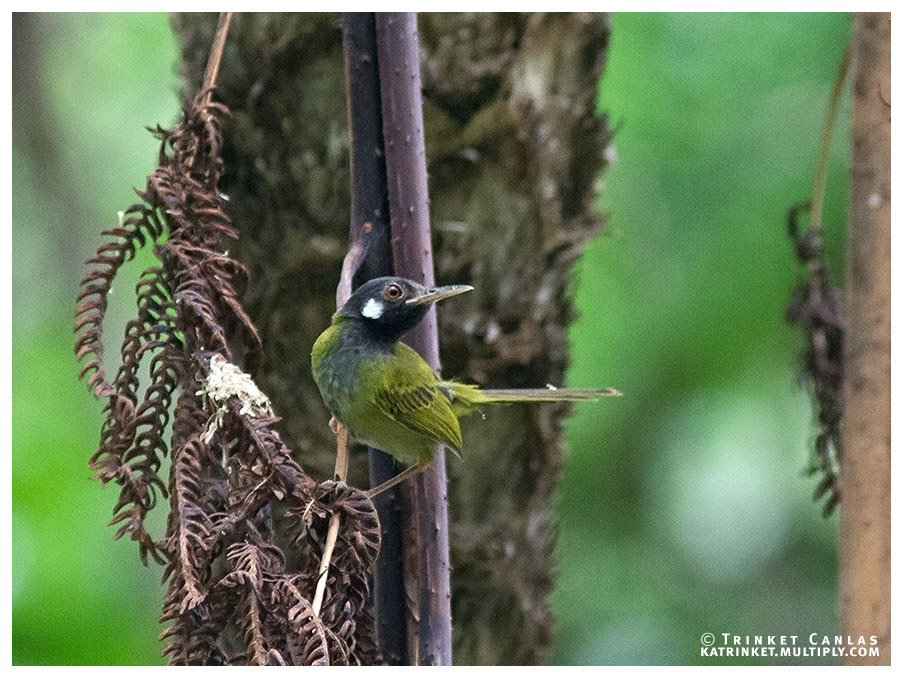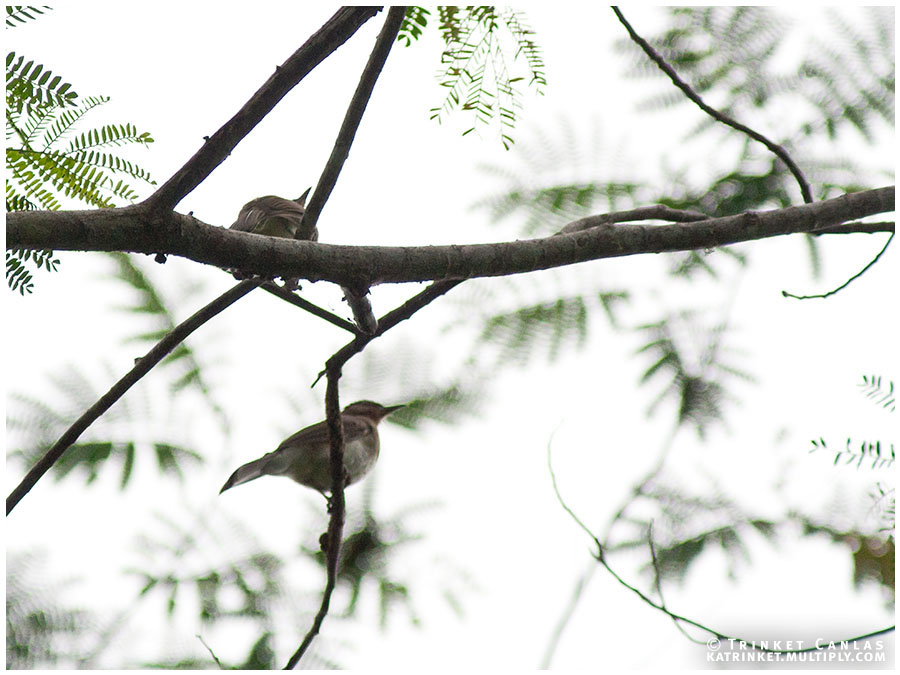WBCP member Carmela Balcazar writes about a club trip to Zamboanga with Christian Perez, Leni Sutcliffe, Trinket Canlas, and Adri Constantino. She gives the lowdown on the best places to stay, eat, and bird!
BIRDING IN ZAMBOANGA
by Carmela Balcazar
Zamboanga City is located at the tip of the Zamboanga Peninsula in southwestern Mindanao. Its colorful past, rich cultural heritage and a penchant for “unwanted excitement” had an appeal that had earned its spot in my list of must-see places. It also reputedly still had the largest chunk of old growth lowland dipterocarp forest remaining in Mindanao. Christian Perez and Leni Sutcliff had been planning a trip since the 1st Asian Birdfest in Davao, and when the trip materialized, I signed up.
City Proper
Our first afternoon was spent exploring the environs of the Lantaka Hotel. The convenient location made it very accessible to several of the city’s tourist attractions, all within walking distance from the hotel. Huge acacia trees line the avenue and had been tagged as historical markers providing shelter for Asian Glossy Starlings. The newly-built Paseo del Mar which was teeming with families was a popular meeting place with its outdoor eateries like the local favorite Alavar. The breakwaters had the iconic scene of Badjao boys in their small outrigger bancas calling out for coins to be thrown into the sea for them to dive for. The historic coastal Fort Pilar lies beside the Shrine of Nuestra Senora del Pilar where outdoor mass is held. Take note of the pigeon house by the entrance of the shrine. Our guide Joel Baysa Jr. who also happens to be the Assistant Protected Area Superintendent remembers it being situated there since he was a child. But for birdwatchers, the main attraction can be found in the downtown area. We were joined by Mary June Bugante, the acting Regional Director of the DOT who proudly gave us a personal tour of her city. Walking past the Commonwealth styled restored City Hall and historical Plaza Pershing, amidst blaring music, and hectic traffic of pedestrians and vehicles, at least a quarter of a million swallows roost in specific streets. Mostly of Pacific Swallows and Barn Swallows, it boggles the mind why they prefer certain streets. Personal space was strictly observed and we amusingly watched how some birds tried to squeeze in to find a spot. While other places provide owling opportunities, in the City of Zamboanga – Swallowing is a tourist activity. It is not to be missed!

Next stop – the Pasonanca Nature Park!
The Pasonanca Nature Park is a quick 20 minute drive from the city. Our first site is the Zamboanga City Watershed found within the confines of the park. Water from the mountain springs are collected and fed into the pumps of the Zamboanga Water District and distributed as the only source of potable water for the city, hence its name “Intake”. We were dropped off at the Muruk DENR ranger station, a picturesque spot with large acacia trees and a hanging bridge along the Tumaga river. We headed towards the Muruk trail which brought us into the interior of the park. The trail is easy with a slight incline, 2-4% slope which made it relatively easy even for our senior birdwatcher Leni to walk on. Barely breaking a sweat and in quick succession we listed Black-naped Monarchs, Yellow-Wattled Bulbuls, Red-keeled, Buzzing, Orange-bellied Flowerpeckers, and a Pied Triller. By 7:30 am, our target, the White-eared Tailorbird was spotted by our guide. Boosted by the early sighting of one of the target birds, we walked eagerly on and soon added White-bellied Woodpeckers, Hair-crested Drongos, Philippine Drongo-cuckoos, and Pygmy Babblers. By the time, we headed for lunch, we added more endemics to our list with the Elegant tit, Stripe-headed Rhabdornis, Black-faced Coucal and another target bird – the Zamboanga Bulbul. One of the highlights of the trail was watching a pair of Black-naped Monarchs build its nest. It was also at this site that I realized that birdwatchers can also be a tourist attraction. After alerting hikers to our presence by asking them to be quiet, they started to pose and take pictures with us as the background!


Lunch was in the Water District Outpost called Double 9. I have to mention lunch because it was the best lunch I’ve had in a birding trip. By special request of the craving Christian, Prawns cooked in Zamboanga’s special sauce and vegetable sour soup (sinigang) with fresh water shrimps were served. To top it off, juicy ripe mangoes and marang was offered for dessert. Satiated, Leni and Christian took power naps while the rest of us opted to hang out by the river. Green Emerald doves, White-throated Kingfishers, Grey Wagtails and the Purple-throated Sunbird subspecies juliae kept us from dozing off.

The afternoon birding had us heading towards the Double 8 station which was upstream of the Tumaga river. On the way there, we passed a large balete (fig) tree where at eye-level and tucked into one of the recess of the tree’s large buttress was a sleeping Philippine Scops owl. Crossing the river to reach the outpost, Trinket and I paid homage to the river spirits by getting partially dunked because of the slippery rocks. While donning our shoes, we looked up just in time to see a Blue-crowned Racquetail noisily flying overhead. Looking for Tailorbirds, it was Adri who realized that what we initially thought was a rodent scurrying in the undergrowth was actually a Red-bellied Pitta! Back and forth, it moved parallel to the trail giving us good views as it went about its business of finding food and resting.


Our return visit would be a morning of “Littles”. At the Double 9 outpost, a lone Little Egret made its way in the rocks. At the river crossing, a Little Heron was foraging and on the Double 8 outpost with its neatly trimmed lawn and pockets of ornamentals, a Little Spiderhunter drank nectar from a torch ginger plant as it caught the first rays of sun. That same morning, the White-throated Kingfishers were busy flashing their wings like exhibitionists and a White-collared Kingfisher had a mouthful with a large praying mantis. Black-naped Orioles swooped and played among the branches. Though the second trip to the Double 9 was cut short by rain, it was far from uneventful. As we made our way to our waiting vehicle, another Mindanao endemic, the Silvery Kingfisher was added to the list.

Baluno
At an elevation of 680 meters, The Baluno Ecological Research and Training Center had seen better days. However, we didn’t go there to check in. We were eager to hit the trails which turned out to be roadside birding and of rolling terrain. Almost immediately, the first bird we spot was a Dollarbird. It would be the first of several we would encounter and it would be typical of the Baluno site. There was more in terms of number and the roadside birding made viewing a lot easier. The surrounding ravines and its wind currents provided opportunities for raptors and needletails. We were rewarded with 4 thermalling Crested Serpent Eagles, a Crested Goshawk, and an unidentified raptor that flew below the tree line before we could positively identify it. The Purple Needletails gave poor Christian a hard time as he tried vainly to photograph them in flight. But raptors did not always rule the roost as demonstrated by an unusual sighting of a Hair-crested Drongo fighting with a Philippine Falconet over perching rights. The numbers of Zamboanga Bulbuls, Philippine Trogons, Coletos, Guaiaberos, and Philippine Drongo-cuckoos gave me a very relaxed opportunity to enjoy the details. 4 km. from where we started, we reached the end of the trail to wait for Rufous Hornbills but alas, they did not show. Instead, the familiar calls of a Plain Bush hen surprised us. We soon headed back in time to shelter from the rains that cut our visit short.




Thanks for this beautiful write up about your trip to Zamboanga City. I hope that whatever apprehensions the other birders have about our city have been dispelled by this.
Vamos a Zamboanga!